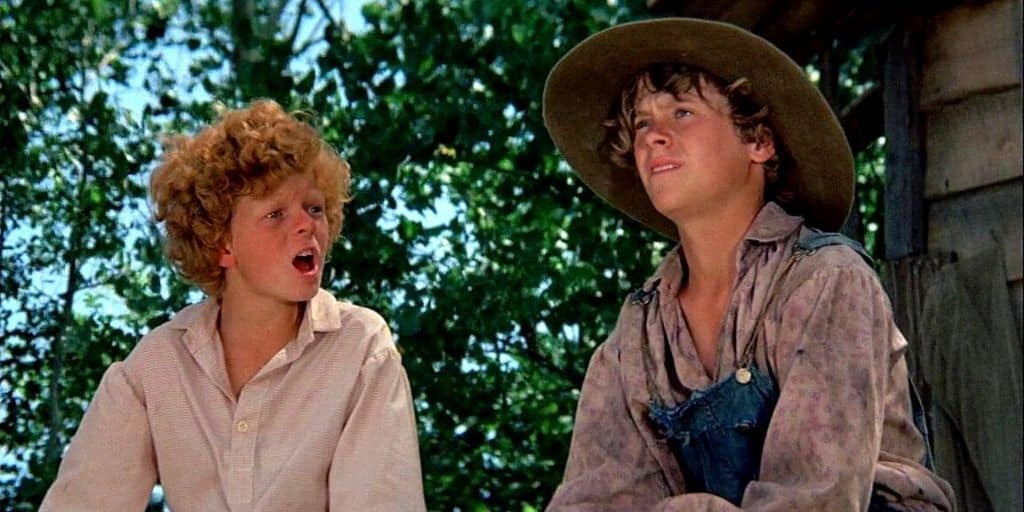Read a character sketch of Tom Sawyer
Tom is the novel’s protagonist: he appears in almost every scene as the main character. Mark Twain did not specify his age, allowing readers to decide for themselves. However, Tom is likely to be around eleven or twelve years old. If he were younger he would not be so interested in Becky Thatcher. Although he tries to get her attention by turning somersaults, behaving foolishly, and passing love notes to her, he does show a caring attitude towards her that indicates a post-puberty attraction. Examples of that are his taking the blame and the punishment for her, and the way he cares for her when they are lost in the cave.
Tom’s age being unclear is deliberately done by Mark Twain as he is able to portray Tom as a child, and treat the reader to a range of childish games and adventures. At the same time he can also trace a development to maturity and allow him to have the insights and impulses of an adolescent, and, indeed, we see Tom following that path. Tom’s high intelligence and unwavering energy unite the two areas of experience that the novel is exploring, in the one single character
So Tom’s character is not static. There is a strong line of development as he moves from pretending to be Robin Hood, and playing “chiefs and Indians,” giving free reign to his imagination, to actions that require a grown-up degree of integrity. Although completely drawn in by these childish fantasy games he is also capable of facing reality. He shows that when he breaks his solemn oath and reveals Injun Joe’s guilt in murdering Dr Robinson. It takes a great deal of moral courage to perform an act that places him in jeopardy in that way, and it’s hardly a childish action – it’s very much something that would tax the thinking and courage of most adults.
Tom is above everything else, a romantic. Our first impression of him is his charisma and his leadership qualities. He initiates and controls all the activities and the other kids follow his lead. Everyone accepts the name of his ‘gang’ – “Tom Sawyer’s Gang,” and look to him to lead. However, the gang’s activities are always products of Tom’s romantic ideas. He is a well-read child, fascinated with the likes of Robin Hood and other romantic heroes and his choice of activities reflects his desire to adapt his life, and those of his friends, to the lives of those heroes.
But Tom is a complex character. For example, while he eggs Huck Finn on to learn and adopt the ways of robbers and pirates, at the same time he tries to persuade him to go back to the Widow and allow her to civilize him so that he can live in society like everyone else.
From a moral point of view, Tom’s actions are quite confusing. Sometimes he’s admirable, but at other times not so much. He tricks the whole town into believing he’s dead, and he takes great pride in that, but he also easily demonstrates his remorse for doing it. He’s always turning his back on the community by truanting, but at the same time he’s also saving lives. In that sense he’s difficult to categorise. He confuses the reader by sometimes being highly admirable and then at other times quite far from being so. However, the true nature of his good heart shines through. Muff Potter would be dead without him.
The Adventures of Tom Sawyer is, to some extent, a story about growing up – a kind of rites of passage story. At the beginning of the novel Tom is a naughty child who feels constrained by such things as school and Sunday school, meal times, and good table manners, and he longs for Huck Finn’s freedom and lazy lifestyle. As the novel progresses, however, and Tom’s adventures multiply, critical moments show Tom moving away from his childish concerns and making more mature, more responsible decisions. We see him testifying at Muff Potter’s trial, although he knows the possible consequences of doing so. We see him saving Becky from punishment, and we join him in his heroic navigation out of the cave where he and Becky have been lost. By the end of the novel, Tom is urging Huck to stay at the Widow Douglas’s, coaxing him to wear tight collars, to attend Sunday school, and to observe good table manners. He has emerged from being someone who tries to subvert the adult order of things. He has become an advocate of respectability and responsibility. As a young person heading towards responsible adulthood, he knows he has to sacrifice the freedoms of childhood and, however boring it may be, take on social customs and conventions.
The process is not entirely coherent, however. There are several narrative streams in the novel and the story is told by weaving among them. The reader follows Tom’s general behaviour to its climax in the Jackson’s Island adventure; his struggle with Injun Joe, ending with the discovery of the treasure; and his affair with Becky, which culminates in his acceptance of blame for her ripping the book.
The novel’s episodic structure makes Tom’s character seem inconsistent. There is no linear development in the storyline. It is picaresque in structure, rather like novels of the 18th century, like Tom Jones by Henry Fielding and Moll Flanders by Daniel Defoe. Sometimes Tom demonstrates the naïveté of a younger child, with his childish fantasies and superstitions. But then, the romantic interest in Becky and his fascination with Huck’s smoking and drinking make him seem more like a teenager. It is not inconsistent, though: there is one consistent characteristic, which is Tom’s tireless pursuit of adventure, which creates a multitude of dramatic moments that push the novel from episode to episode. He goes through a great deal of experiences, exasperating some of the town’s inhabitants but ends up being the town hero, albeit with his contrasting nature recognised by the town gossips who say that he “would be President yet, if he escaped hanging.”
That’s our Tom Sawyer character analysis. Make sense? Any questions? Let us know in the comments section below!

Tom Sawyer character with Huckleberry Finn in the 1973 movie




Great synthesis. Haven’t opened that story since high school and you hit it, particularly the lack of consistent character development of Tom.